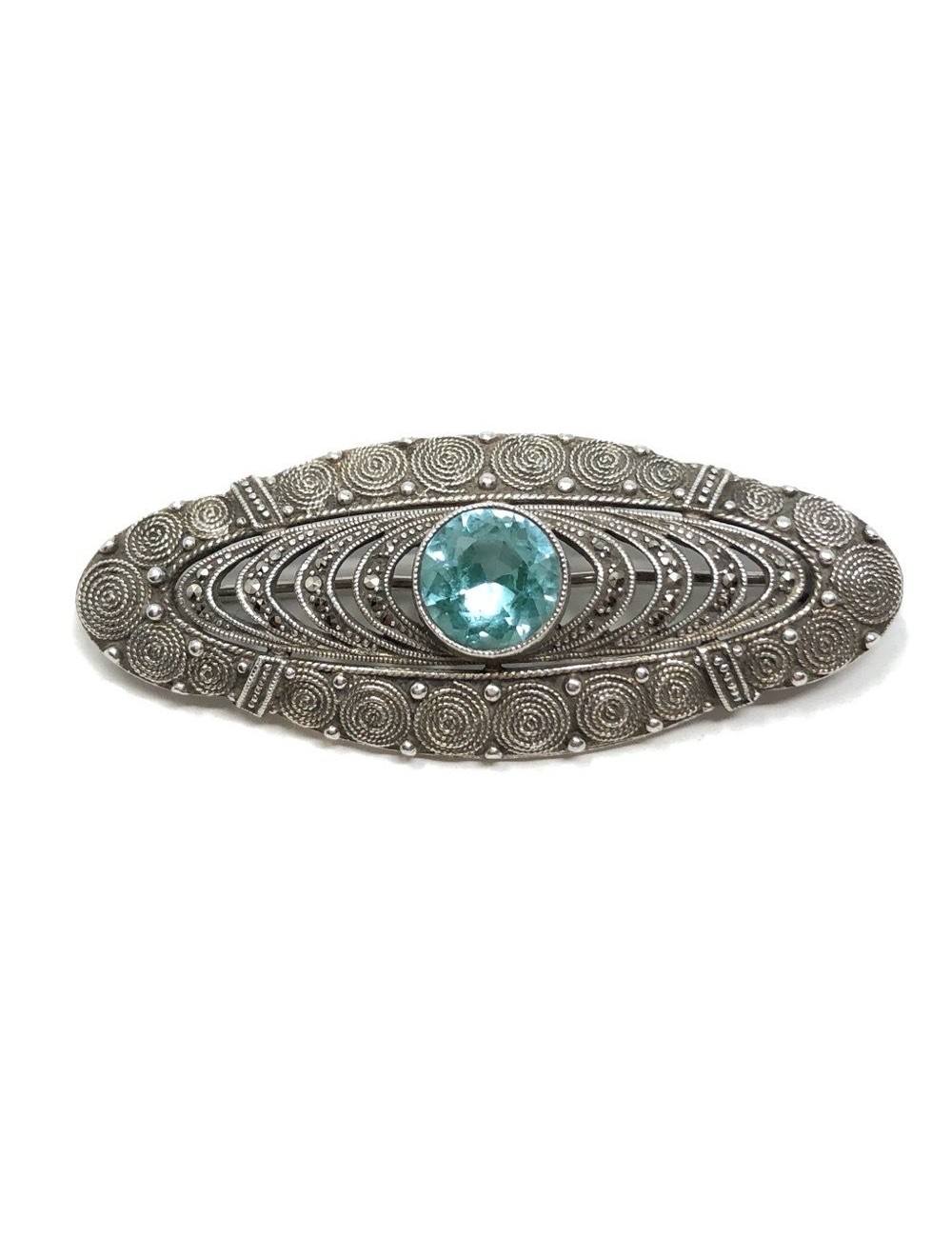- On sale!
- -25%










This brooch is a beautiful example of the Art Deco silver work of the German Theodor Fahrner company.
Condition Report:
Excellent
For more information about this brooch, read below...
The Details...
This oval shaped brooch is constructed from silver. It features swirling designs in silver filigree work and is set with Marcasites. At the centre of the brooch is a large, round, bezel set, Aquamarine coloured crystal. The brooch fastens using a traditional safety catch and the fastening pin is fitted to the reverse of the brooch with a tube hinge. It is signed. The back of the brooch features 'ORIGINAL FAHRNER' and 'TF 925' stamped into silver panels on the reverse. The brooch measures 5.5cm x 2cm. To learn more about Theodor Fahrner jewellery, visit our 'Designers' section.
A Short History...
This brooch is part of a collection of filigree jewellery, which the Theodor Fahrner company produced post 1932. The filigree designs were produced when the silver was soldered with corded wire. Fahrner jewellery of this type features prominently in the book 'Theodor Fahrner Jewellery - Between Avant Garde and Tradition' .
Wear it With...
Pin this brooch to a black leather jacket. Silver courts and sleek silver hair accessories will also compliment this piece.
The jewellery within the Gemma Redmond Vintage collection has survived to this day because it has been well cared for throughout its lifetime. It is important to continue to care for the jewellery that you buy from us to ensure its continued preservation. Here are some suggestions:
- Be sure to store your jewellery within the boxes that we provide to ensure that it is protected. This is especially important when travelling with your pieces.
- Try not to get perfume or hairspray on your items. These liquids can damage the materials that our jewellery is made from.
- Try not to drop your jewellery or catch your jewellery against hard surfaces. If this happens over time, the findings and fixings can loosen and wear.
- Try not to get your jewellery wet. Some costume jewellery manufacturers utilised water soluble glue in the making of their pieces. Getting your jewellery wet could cause rhinestones and other details to fall away over time.
- If you wish to clean your jewellery, use a soft polishing cloth or a soft brush.
Exceptionally rare and intricate, this Austro-Hungarian brooch was created in the mid 1800s.
Condition Report:
Good - Some wear to the enamel work and a tiny chip to the right-hand edge of the brooch. These aspects are only apparent upon very close inspection and do not detract from the appeal and rarity of the piece.
For more information about this brooch, read below...
This beautiful brooch is emblematic of quality Art Deco paste jewellery.
Condition Report:
Excellent
For more information about this brooch, read below...
This beautiful brooch was most likely created in the Victorian era. It features a pretty floral design.
Condition Report:
Excellent
For more information about this brooch, read below...
This elegant bar brooch features a classical portrait and was most likely created in France in the early 1930s.
Condition Report:
Very Good -Some minor discolouration to the metal surrounding the portrait. This is only visible upon very close inspection.
For more information about this brooch, read below...
This lovely brooch dates from the late 1950s.
Condition Report:
Excellent
For more information about this brooch, read below...
A beautifully designed late 1960s brooch featuring shimmering stones.
Condition Report:
Excellent
For more information about this piece, read below...
This pretty brooch dates from the 1940s. It's a delightful example of French silver.
Condition Report:
Excellent
For more information about this brooch, read below...
This whimsical brooch features an intricately decorated bug and dates from the Victorian era.
Condition Report:
Excellent
For more information about this brooch, read below...
This elegant brooch was created in the mid to late 1800s.
Condition Report:
Very Good - A tiny piece of the granulation (gilded metal beading) is missing from the design. This is only apparent upon very close examination and does not detract from the appeal of the piece.
For more information about this brooch, read below...
This lovely brooch reflects the vogue for wooden jewellery during the 1940s. It resembles early pieces created by the American Miriam Haskell company and some Czechoslovakian jewellery designs.
Condition Report:
Excellent
For more information about this brooch, read below...
This pretty brooch dates from the 1920s and was made in France.
Condition Report:
Very Good - Some rubbing to the metallic highlighting on the brooch. This is consistent with age and use and does not detract from the appeal of the piece.
For more information about this brooch, read below...
This beautiful brooch is a lovely example of Art Nouveau carved horn jewellery. It is unsigned.
Condition Report:
Excellent
For more information about this brooch, read below...
Stylish and symbolic, this brooch was created the mid to late 1800s.
Condition Report:
Excellent
For more information about this brooch, read below...
This elegant example of 1940s design is an unsigned beauty.
Condition Report:
Very Good - Some minor oxidisation to the metal surface underneath two petals. This is only visible upon close inspection and cannot be seen when the brooch is worn.
For more information about this brooch, read below...
This pretty 1950s brooch was most likely created in Austria.
Condition Report:
Excellent
For more information about this brooch, read below...
This shimmering brooch was created in the mid to late 1800s in Czechoslovakia.
Condition Report:
Excellent
For more information about this brooch, read below...

This brooch is a beautiful example of the Art Deco silver work of the German Theodor Fahrner company.
Condition Report:
Excellent
For more information about this brooch, read below...